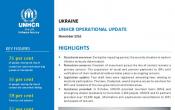Russian Federation
Operation: Russian Federation
Location
{"longitude":80,"latitude":59,"zoom_level":3}
Latest update of camps and office locations 21 Nov 2016. By clicking on the icons on the map, additional information is displayed.
Key Figures
| 2017 planning figures | |
| 100% | of cases of potential refoulement will be prevented |
| 100% | of applicants will have access to refugee status determination (RSD) procedures |
| 100% | of people of concern will have access to national primary health care facilities |
| 14,000 | refugees and asylum-seekers and 2,500 stateless people will receive legal assistance |
| 500 | Governmental staff will be trained on RSD procedures |
| 2015 end-year results | |
| 14,259 | asylum-seekers, refugees and stateless persons received support from a legal network of some 100 lawyers, including UNHCR’s legal partners in many parts of the country, including regions in Siberia, the Far East, and on the western borders of Russia |
| 37 | individuals were supported through their naturalization process |
| 57 | cases (111 persons) were submitted for resettlement, of which 47 cases (79 persons) were accepted; 62 cases (112 persons) departed for resettlement in 2015 |
Latest Updates and Related Links
People of Concern
18%
Increase in
2015
2015
| 2015 | 418,411 |
| 2014 | 354,450 |
| 2013 | 189,957 |

[["Refugees",314506],["Asylum-seekers",2088],["Returned refugees",4],["Stateless",101813]]
Loading ...
Budgets and Expenditure for Russian Federation
< Back
2015
{"categories":[2012,2013,2014,2015,2016,2017],"budget":[10.09417472,8.43188109,7.08626894,6.115651963,5.52486729,5.783781328],"expenditure":[7.45743621,5.96699989,4.81179465,3.81659835,null,null]}
{"categories":[2012,2013,2014,2015,2016,2017],"p1":[9.58747631,7.83837767,6.39498853,5.432067327,5.09438145,5.227422661],"p2":[0.50669841,0.59350342,0.69128041,0.683584636,0.43048584,0.556358667],"p3":[null,null,null,null,null,null],"p4":[null,null,null,null,null,null]}
{"categories":[2012,2013,2014,2015,2016,2017],"p1":[6.9871334,5.44928767,4.27754774,3.20615022,null,null],"p2":[0.47030281,0.51771222,0.53424691,0.61044813,null,null],"p3":[null,null,null,null,null,null],"p4":[null,null,null,null,null,null]}
Loading ...
CHOOSE A YEAR
- 2014
- 2015
- 2016
- 2017
Working environment
Since the outbreak of the conflict in south-eastern Ukraine in April 2014, some 1.1 million Ukrainians had sought asylum or other forms of legal stay in the Russian Federation by July 2016. The Government continues to lead the operational response to the needs of arrivals from Ukraine.Newly-arrived asylum-seekers from countries other than Ukraine sometimes face difficulties with access to territory and to asylum procedures. They also experience longer waiting periods and are exposed to risks associated with the absence of documentation, including deportation. Furthermore, decisions on their status often prioritize the Temporary Asylum status as a form of complementary protection over refugee status even in cases when the applicant may meet the definition set in the 1951 Convention relating to the Status of Refugees.
Similarly, while local integration is generally an option available to Ukrainian refugees, it remains problematic for other population groups due to absence of governmental programmes to assist refugees with accommodation, jobs, language, and overcoming legal/bureaucratic obstacles, as well as incidents of xenophobia.
Access to education remains challenging for refugees and asylum-seekers due to the regulation requiring registration at the place of sojourn for admission to local schools.
UNHCR will continue working with the authorities to improve access to and quality of the national status determination procedure and promote integration opportunities for recognized refugees and temporary asylum holders. UNHCR ensures individual legal assistance and counselling through partner organizations and lobbies for individual cases before national courts and, in selected cases, with the European Court for Human Rights. In addition, the Office pursues resettlement to third countries when refugees, for various reasons, cannot find protection and achieve integration in the Russian Federation.
By law, applicants for refugee status, holders of temporary asylum and refugees in the Russian Federation are entitled to free medical care. However, UNHCR also provides assistance through its partners to applicants who face difficulties accessing this entitlement or who have serious health problems that are not covered by the obligatory insurance.
The number of stateless people in the country is progressively reducing, thanks to a number of legislative changes. However the problem has not yet been fully resolved and the estimated stateless population stands at just over 100,000. UNHCR continues to implement awareness-raising activities and to provide legal assistance through partner organizations for people seeking to regularize their status, and stands ready to provide relevant support to the Government.
Key priorities
In 2017, UNHCR's Operation will focus on:• Promoting unhindered access to the territory for asylum-seekers, especially from international airport transit zones and land borders, including through the establishment of cooperation with the Border Guards Service;
• Working with migration service staff to improve reception conditions and temporary accommodation centres;
• Providing capacity building for government officials to ensure access to quality RSD procedures and individual documentation;
• Building partners’ capacity to provide quality legal services to asylum-seekers, refugees and stateless people;
• Supporting the Government in developing integration programmes for recognized refugees and temporary asylum status holders, while promoting the removal of legal and practical barriers to integration;
• Lobbying the Government for its accession to international instruments, as well as legislative amendments to further reduce and prevent statelessness.
• Lobbying authorities to facilitate naturalization procedures for refugees and stateless people and advocate for their access to social services.


